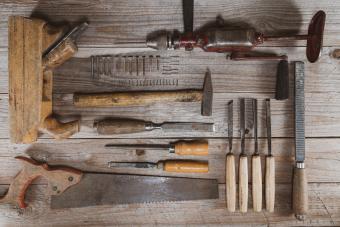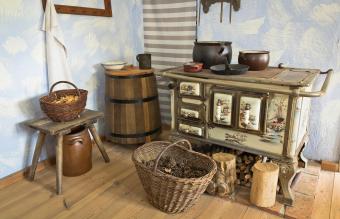
Katerina Skokanova / EyeEm / Getty vintage antique woodworking tools displayed on table
People have been using tools to help with everyday activities for thousands of years, and antique tool identification requires a process of carefully examining the tool and asking yourself a series of questions about it. If you've found an antique mystery tool you need to identify, this basic process can help.
Determine Whether It's Really a Tool
Before you get into the details of vintage tool identification, you need to determine whether what you have really is a tool. Pieces of other things can sometimes seem like antique mystery tools, but there are clues that what you have may actually be part of something else. If it has holes or hardware for attaching it to something, it may be a part and not an entire tool. Similarly, if one surface shows less wear than the others, this may be the place it joined to something else.
To determine whether what you have is actually a tool, it also needs to have a use. Does the item you have do anything? Does it seem to fulfill a function? Not every tool has moving parts, but tools are distinctly utilitarian. For instance, a hammer is meant to be used and has a handle for you to hold. Turn the item over and give some thought to how it might have been used.
Look for Clues About Its Age

Anton Petrus / Moment / Getty antique tools on weathered wooden table
You should also take a moment to determine whether the item you have is actually old. When it comes to most tools, an antique must be at least 100 years old, and a vintage tool must be at least 20 years old. Look at these specific aspects of the tool to find out about its age:
- Patina - The item should show signs of use and wear. Depending on the materials, it could also be tarnished or rusty. There could be chipped paint. All of this is called the "patina."
- Materials - An older tool may be made of materials that don't feel modern. Worn wood, cast iron, and even glass can help you identify an antique tool. Stainless steel and plastic usually indicate a tool from the 20th century.
- Construction methods - How the tool was made also offers a clue. If it has signs of hand carving or hand-finished surfaces, it may be quite old.
Identify the Antique Tool's Purpose
Once you know you have a tool and that it's probably an antique, the next step in identifying it is determining what the tool actually does. When it comes to vintage tool identification, what it does tells you what it is. If you're an antique tool collector, you may already be able to sort out of a lot of different vintage hand tools, but there are always antique mystery tools. These tips can help you figure out what you have.
Decide Whether It's Light or Heavy Duty

A large, heavy item was probably designed for heavy duty use rather than fine work. For instance, a sledge hammer isn't used for making jewelry. The size and weight of the tool aren't the only clues about whether it's light or heavy duty, however. You can also look at how fine it is. When it comes to the teeth on a saw, for example, finer teeth may indicate finer work. Similarly, the precision of the tool can indicate a light or fine duty implement.
Examine the Vintage Tool's Action

Helder Faria / Moment / Getty antique bench vice clamp
If the tool moves in some way, what does it do? For example, pliers pinch together, and that action indicates their purpose. There are several common actions that can help in vintage or antique tool identification:
- Cutting - Is the tool sharp? Does it have teeth or a cutting surface?
- Holding - Does it clamp things together or hold parts of something in place?
- Striking - Is there a flat surface on the tool designed to strike another surface or an object?
- Piercing - Does the antique tool have a sharp point?
- Turning - Is the tool designed to turn something?
Check the Materials Used in Its Construction
When it comes to identification of mystery antique tools, the materials can offer some information about the tool's purpose. Is the tool made of a precious metal or fine material like ivory, ebony, or tortoiseshell? If so, it's probably meant for light duty work, such as use in a dining room or bedroom.
If the tool is made of iron, wood, steel, or another heavy duty material, it can indicate that the tool was designed for a purely utilitarian purpose. It's made to do something, and it was less important that it look pretty while doing that task.
Examine It for Residue and Wear Marks

Bernard Van Berg / EyeEm / Getty variety of antique tools displayed on table
Does the tool have grease or oil in the moving parts? Does it have bits of sawdust or metal shavings in the crevices? Any residual materials left from the tool's original use will help you determine what it did. A woodworking tool may have sawdust. A jeweler's tool may have shavings of silver or other metals.
Most antique tools were used at some point in their history, so you'll usually see some type of wear on the tool. Examine this carefully. The pattern of the wear marks, their placement, and the shape of them can help tell you what the tool does. For example, an antique hand drill may be worn on the bit or handle. Worn areas on handles can also help you determine how the tool was held when it was used.
Look for Antique Tool Identification Marks
Like many antiques, tools can have identification marks that can offer a lot of information. While there's no tried and true antique tool identifier that will give you an answer about the tool every time, maker's marks and stamps are pretty close. Examine the tool carefully for anything that looks like a mark. These are a few of the places to check:
- Blades or cutting surfaces
- Shafts
- Metal parts, especially those with flat surfaces for stamping
- Handles
Once you have located the stamp or label, make some notes about what it looks like. The name or initials can help you in unusual antique hand tool identification because they offer clues about the manufacturer, the company that sold the tool, or the date when the tool was made. You may also find a patent number, which you can look up at the US Patent and Trademark Office.
Spot the Most Valuable Antique Mystery Tools
While identifying antique mystery tools can help you satisfy your curiosity about unusual objects you may find in antique stores or flea markets, it can also be an essential part of determining whether you have a valuable treasure. Some vintage and antique tools are worth a lot of money, so being able to tell what kind of tool you're looking at will help you snap up these beauties when you see them or ask the right price if you're planning to sell.







